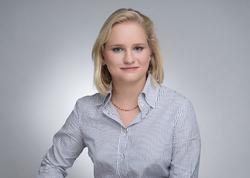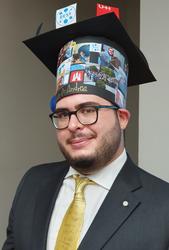URL: https://vffd.desy.de/e25/e330307/index_ger.html
Breadcrumb Navigation
Promotionspreis 2022
Der Promotionspreis wurde am Science Day, dem 23. November 2022, verliehen. Er geht zu gleichen
Teilen an Frau Dr. Sarah Schröder für ihre Dissertation mit dem Titel
“External injection of electron beams into plasma-wakefield accelerators”
und an Herrn Dr. Andrea Cardini für seine Dissertation mit dem Titel
“Measurement of the CP properties of the Higgs boson in its decays to τ leptons with the CMS experiment ”
Sarah Schröder was born on April 30th, 1990, in Heidelberg, Germany. She studied for her bachelor’s at the Universität Stuttgart and for her master’s at the Universität Hamburg. In 2016, she joined the FLASHForward project at DESY to research on the topic of plasma-based particle accelerators under the supervision of Jens Osterhoff, Bernhard Schmidt, and Brian Foster.
Plasma-based particle accelerators support accelerating fields in the GV/m-range that can outperform metallic cavity-based accelerators by several orders of magnitude, providing a viable path to miniaturize particle-accelerator modules for future particle physics and photon science applications. The realization of an application-ready plasma-accelerator module requires precision control over the accelerating fields to yield particle beams of sufficient quality and to enable a high-efficiency acceleration process. In her PhD research, Sarah Schröder devised and implemented a novel measurement scheme for the direct high-fidelity characterization of the accelerating field structures in a plasma wake. Sarah’s scheme solved an important and complex problem as the accelerating structures propagate with the speed of light through the plasma and evolve on sub-picosecond timescales, thus, high spatial (µm) and temporal (fs) resolution is necessary. A proof-of-principle experiment was published in the journal Nature Communications in 2020 with Sarah as the first author.
Since then, this novel detection scheme has been deployed at the FLASHForward experiment as a key ingredient to measure and enable precision-controlled and optimized plasma fields. In a study by C.A. Lindstrøm, J.M. Garland, S. Schröder et al. published in Physical Review Letters in 2021 a record-setting energy transfer efficiency of 42% was achieved while simultaneously preserving the energy bandwidth of plasma-accelerated electron beams at the 0.1% level—a factor of 10 improvement over the previous state-of-the-art.
These developments are critically important milestones on the path to first applications of plasma-based acceleration systems and directly emerged from Sarah Schröder’s PhD work.
Consequently, the community acknowledges Sarah’s contributions: She has presented her research as an invited plenary speaker at several important international conferences (IPAC 2021, EAAC 2019) and has received, both, the 2022 Dissertation Prize of the Helmholtz Association for Mission-Oriented Research and the Dissertation Prize of the German Physical Society (DPG) Section Matter and Cosmos.
Today, Sarah Schröder is a Fellow in the DESY Particle Physics Division.
Andrea Cardini studied at the University of Florence and came for the first time at DESY as a summer student, where he enjoyed very much the athmosphere of the DESY CMS group and decided then to apply for a PhD position. He was the best among the interviewed students at the time and
the group immediately offered him a position in the Higgs group.
When the Higgs boson was discovered by the ATLAS and CMS in 2012, very few of its properties were known. The year after it was established that the Higgs boson had spin zero, as predicted in the Standard Model. However, its CP property, i.e. to be an even CP state, was largely unknown until few years ago. The PhD thesis of Andrea Cardini was the first measurement of this property in a very novel and model independent way, looking at the decay products of the Higgs boson into tau leptons.
Andrea Cardini first studied a lot the theory and the best methods to determine these CP properties via correlations of the directions of the tau decay products. He wrote a lot of code, which is the basis of many analyses used in the group until now. The analysis requires a perfect understanding of the data and all possible corrections needed to the simulation, in order to keep the systematic uncertainties under control. Throughout the work, Andrea showed to be a very competent and young researcher, able to tackle a very complex analysis with original ideas and solutions. The results that Andrea achieved were outperforming our initial expectations and overall a CP-odd state for the Higgs could be excluded at three sigma. The result was published in 2021 and presented as highlight at many Higgs conferences.
Andrea was always very helpful with other members of the group and he continues now as fellow at DESY. During the pandemic he was a big help for many of his younger colleagues. He is now continuing to exploit his expertise on tau final states on searches beyond the Standard Model and rarer processes.





